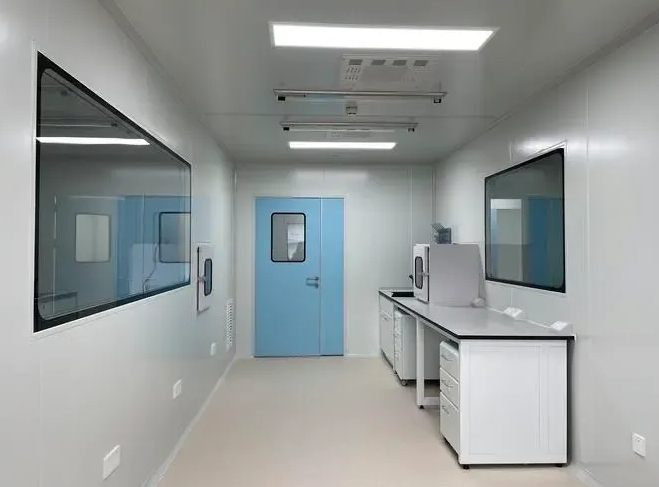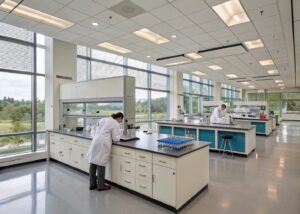Table of Contents
Designing a cell culture laboratory requires precision, planning, and a deep understanding of the unique needs of biological research. As an expert in laboratory design and planning based in the China, I have worked on various projects that prioritize efficiency, safety, and scalability. In this article, I’ll walk you through the essential elements of cell culture laboratory design, focusing on creating a functional, future-proof space that meets stringent industry standards.
Layout and Zoning: The Backbone of Effective Cell Culture Laboratory Design
A well-planned layout is the cornerstone of successful cell culture laboratory design. The primary goal is to ensure a smooth, unidirectional workflow that minimizes contamination risk and boosts efficiency. Key zones to consider include:
- Cell Culture Area: This is the heart of the laboratory, housing critical equipment like biosafety cabinets and CO2 incubators. Position this area away from high-traffic zones to reduce the chance of contamination.
- Preparation Zone: A separate space for media and reagent preparation, typically featuring laminar flow hoods to maintain sterility during critical processes.
- Analysis Station: A designated area with microscopes and other analytical tools for examining cell cultures.
- Storage Section: This should be a temperature-controlled area for safely storing samples, media, and reagents. Proper organization in this zone ensures that materials are easily accessible and contamination is minimized.
By zoning your lab into these distinct areas, you’ll streamline the workflow, ensuring that processes flow logically from preparation to analysis.
Air Quality Management: A Non-Negotiable Element
Air quality is crucial in cell culture laboratory design to avoid contamination that can ruin research. Here’s how to ensure top-notch air quality:
- HEPA Filtration: Install high-efficiency particulate air (HEPA) filters to remove airborne contaminants.
- Positive Pressure: Maintain positive pressure in the culture area to keep out unfiltered air and external contaminants.
- Ventilation Systems: Use separate ventilation for different lab sections to prevent cross-contamination.
Incorporating these air quality measures will ensure that your laboratory provides the clean environment essential for cell culture work.
Equipment Selection and Placement: Maximizing Efficiency
The success of your cell culture laboratory heavily depends on the selection and strategic placement of your equipment. A few considerations include:
- Biosafety Cabinets: Choose the appropriate class (I, II, or III) based on your research needs and safety requirements.
- Incubators: Position them in low-traffic, easily accessible areas to avoid disturbances during critical incubation periods.
- Centrifuges: Place on anti-vibration platforms to ensure smooth operation and minimize noise and movement disruptions.
- Microscopes: Create a dedicated space for analysis, ensuring proper lighting and ergonomics for researchers.
Careful placement of these instruments not only improves operational efficiency but also reduces the risk of accidents and contamination.
Choosing the Right Surfaces and Materials
Your lab’s surfaces should be resistant to chemicals, easy to clean, and durable. Here’s what to consider:
- Non-Porous Materials: Opt for non-porous surfaces, such as stainless steel or specialized resin, for workbenches and counters. These materials are highly resistant to both chemical spills and microbial contamination.
- Seamless Flooring: Choose flooring materials that are easy to clean and free of seams, which can harbor contaminants over time.
The right materials ensure a hygienic environment while standing up to the wear and tear of daily lab activities.
Environmental Control Systems: Keeping Conditions Optimal
Environmental stability is crucial in any cell culture laboratory design. To maintain the right conditions:
- Temperature Control: Install reliable HVAC systems to ensure precise temperature control, which is critical for cell growth.
- Humidity Management: Control humidity to prevent condensation, which can interfere with equipment and experiments.
- Lighting: Use adjustable LED lighting, which produces less heat, reducing the likelihood of equipment malfunctions and ensuring proper light conditions for cell culture work.
Maintaining a stable environment is critical for the consistent success of your cell culture experiments.
Safety Features: A Top Priority in Cell Culture Laboratory Design
Safety should always be at the forefront of cell culture laboratory design. A few key safety features include:
- Emergency Showers and Eyewash Stations: Position them in easily accessible locations in case of chemical exposure.
- Proper Chemical Storage: Utilize specialized cabinets to store volatile or hazardous chemicals securely.
- Clear Safety Signage: Make sure that all safety protocols, emergency exits, and equipment are clearly marked.
- Personal Protective Equipment (PPE): Provide ample space for PPE and ensure researchers have easy access to gloves, gowns, and masks.
Prioritizing safety protects both researchers and the valuable work being done.
Utilities and Infrastructure: Supporting Lab Operations
Your cell culture lab needs robust infrastructure to ensure smooth operation. Key considerations include:
- Uninterrupted Power Supply: Use backup generators to safeguard critical equipment from power outages.
- Water Systems: Install high-purity water systems with appropriate filtration for washing glassware and preparing solutions.
- Gas Supply: Ensure secure storage and consistent supply of essential gases like CO2 and nitrogen.
Reliable utilities are vital for maintaining the continuity of research in a cell culture laboratory.
Flexibility and Future-Proofing Your Design
The field of cell culture is rapidly advancing, so your lab should be flexible enough to accommodate future innovations. Consider:
- Modular Furniture: This allows easy reconfiguration as your research needs evolve.
- Expandable Utility Connections: Plan for future equipment that might require additional electrical, water, or gas supply.
- Space for New Equipment: Leave room for growth by designing with extra space in mind for future installations.
This forward-thinking approach will ensure your lab remains functional and relevant as technology advances.
Contamination Control: A Continuous Focus
Contamination can undermine months of research, so it’s critical to implement contamination control strategies:
- Anterooms or Airlocks: These buffer zones can prevent contaminants from entering the main lab area.
- Hands-Free Door Operations: Reduce the risk of contamination by installing doors that don’t require hand contact.
- Dedicated Gowning Areas: Ensure researchers change into clean lab attire in designated areas before entering the lab.
Strict contamination control measures are essential for preserving the integrity of cell cultures.
Data Management and Connectivity: Integrating Technology
In today’s digital age, integrating technology into your cell culture laboratory design is crucial. Make sure to include:
- Data Ports and Wi-Fi Coverage: Provide enough data ports and reliable Wi-Fi to support computers, tablets, and lab management software.
- Computer Workstations: Allocate sufficient space for data entry and analysis stations.
- Software Integration: Use lab management software to streamline processes, ensuring efficient data management and traceability.
Incorporating modern technology can significantly enhance your lab’s efficiency and data accuracy.
Conclusion: Crafting a Cutting-Edge Cell Culture Laboratory
Designing a cell culture laboratory involves more than just selecting equipment; it’s about creating a space that fosters scientific innovation. By focusing on zoning, air quality, safety, and future-proofing, your lab will not only meet current research needs but also be well-prepared for future advancements.
As a laboratory design expert in the China, I encourage you to consult with experienced professionals to tailor your design to your specific goals. With the right planning and execution, your cell culture laboratory will become a hub of scientific breakthroughs for years to come.




